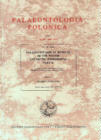| PALAEONTOLOGIA POLONICA VOL. 65 | |
 |
Editor: Jerzy Dzik Editors of the volume: |
EARLY TRIASSIC VERTEBRATE ASSEMBLAGE FROM KARST DEPOSITS AT
CZATKOWICE, POLAND |
|
PREFACE The Early Triassic (early Late Olenekian) fauna of small vertebrates presented in this volume comes from karst deposits developed in Early Carboniferous (Turnaisian to Mid Visean) limestone at the Czatkowice quarry near Kraków (Southern Poland). All the material comes from a single exposure, referred to as Czatkowice 1. In Czatkowice quarry the bone−bearing breccia was first collected from waste−heaps, but was eventually discovered in situ by a team from the Institute of Geological Sciences of Jagiellonian University, Kraków (Paszkowski and Wieczorek 1982). Unfortunately, the geology of the site was only briefly studied, because of the rapid exploitation of the quarry. The original description of the geological setting is that of Paszkowski and Wieczorek (1982). Through the kindness of colleagues from the Jagiellonian University (and notably Ryszard Gradziński), the material was transferred to Teresa Maryańska and Halszka Osmólska (Museum of the Earth and Institute of Paleobiology of the Polish Academy of Sciences, Warsaw, respectively), who took part in the exploration of the site and performed a preliminary paleontological examination. The bone−bearing breccia was subjected to chemical preparation in acetic acid in the Museum of the Earth and the Institute of Paleobiology, Polish Academy of Sciences. However, more effective preparation started only in the 1990’s and has now terminated. Around this time, Halszka Osmólska and Teresa Maryańska, both fully engaged in dinosaur studies, kindly offered the Czatkowice 1 material to one of us (MBB). A more detailed study then began in collaboration with Susan Evans from University College London, first under the British/Polish Joint Collaboration Programme funded by the British Council and Polish State Committee for Scientific Research (1993–1996), then only under the latter organization (2000–2003; 6 P04D 072). We were later joined by colleagues who contributed to the study of particular groups. Michail Shishkin, a fossil amphibian expert from the Paleontological Institute of the Russian Academy of Sciences (Moscow), took over the temnospondyl material in collaboration with Tomasz Sulej (Institute of Paleobiology); Andriej Sennikov from the Paleontological Institute of the Russian Academy of Sciences (Moscow) contributed to the work on archosauriforms; and Mariusz Lubka, a PhD student from Wrocław University, contributed to the procolophonian paper. This long and detailed project would not have been possible without the help and support of many people, especially the technical staff of the Institute of Paleobiology and Museum of the Earth who completed the time−consuming chemical preparation of the matrix and the recovery of bone fragments. We are particularly indebted to Ewa Hara for her exquisite preparation work, to Cyprian Kulicki for SEM micrographs, to Marian Dziewiński for photography, and to Aleksandra Hołda−Michalska for most of computer illustration work. In total, several hundred kilograms of Czatkowice 1 breccia were processed, yielding around 1500 catalogued specimens and many thousands of valuable unnumbered specimens. Early Triassic tetrapod faunas are of particular interest in documenting the biotic changeover that took place on land at the Permo−Triassic boundary (Ochev 1993). In terms of Scythian paleogeography, these faunas are best known from the temperate latitudes of southern Gondwana (primarily in South Africa, Australia and Antarctica) and, in the northern hemisphere, from the areas adjacent to the circumequatorial xeric belt (such as Eastern Europe and Greenland). The belt represented a vast arid/semiarid zone which included, in particular, most of Central and Western Europe (Lozowsky 1993). It was inhabited by impoverished tetrapod communities largely concentrated within and around freshwater basins. Accordingly, their fossil record is usually dominated by aquatic temnospondyl amphibians (Shishkin and Ochev 1993). In this context, the Early Triassic tetrapod assemblage from Southern Poland, surveyed for the first time in its entirety in the present volume, deserves special attention. Although it came from the xeric belt, its structure differs notably from that of other assemblages from elsewhere in the same climatic zone (mostly in Central Europe and North American southwest). In contrast to them, the Polish fauna is dominated by a terrestrial component, with abundant archosauriform reptiles, while the bones of aquatic amphibians are much rarer. This “reversed” pattern of faunal preservation unquestionably resulted from the specific environmental setting and unusual mode of burial of the Czatkowice vertebrates (Shishkin and Sulej 2009). Their remains were accumulated in karst fissures developed within the upland relief rather than in the lowland floodplain deposits that typically host vertebrate fossils. As a result, unlike most other localities, there was no preferential burial of aquatic or subaquatic animals. The unusual conditions under which the Czatkowice 1 locality developed were probably responsible for the presence of a number of exceptionally rare forms, such as stem−frogs, small lepidosauromorphs, and the earliest euparkeriid archosaurs, all hitherto unknown from the Early Triassic of Laurasia. On the other hand, the Czatkowice temnospondyl amphibians have been found to be readily comparable at generic level with those of East Europe, where they provide a basis for high resolution subdivision of the regional Triassic faunal succession (Shishkin and Ochev 1993; Shishkin et al. 2000). This correspondence is regarded as a decisive factor in dating the Polish assemblage. In summary, these new records and the often exquisite preservation of the material from which they are described, make a significant contribution to our current knowledge of early Mesozoic land vertebrates. The Editors |